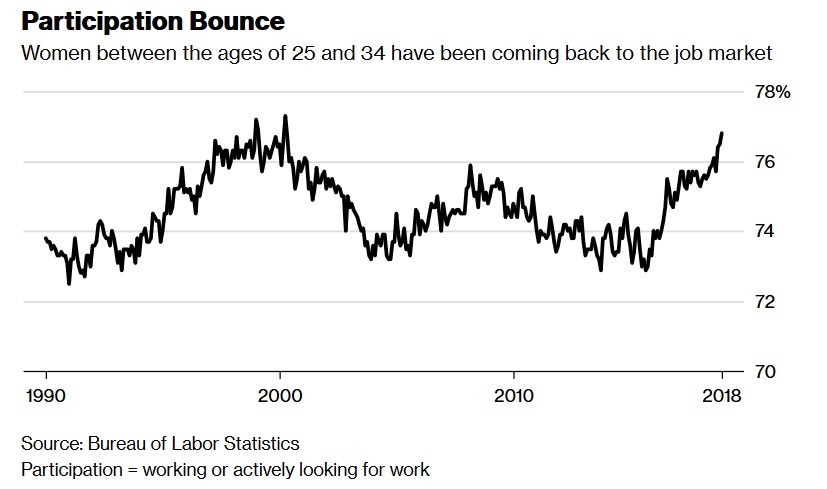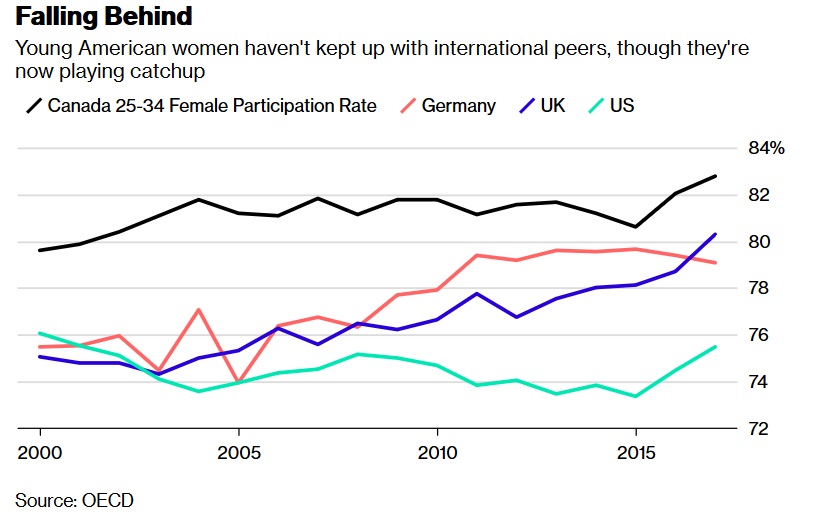 Cultural shifts are partiallyresponsible for the increase in working millennial women, aseducation levels are increasing and benefits for workingparents proliferate. (Image: Shutterstock)
Cultural shifts are partiallyresponsible for the increase in working millennial women, aseducation levels are increasing and benefits for workingparents proliferate. (Image: Shutterstock)
Millennial women are participating in the American job market at levels last seen in 2000 aspeople like Remya Ravindran dive back into the labor pool.
|Ravindran landed a job at Quizlet, a San Francisco-basedtechnology company, in late 2018 after taking two years off tocare for her baby. The 29-year-old softwarequality-assurance engineer says she wanted to become thehousehold's second breadwinner and use her education in a labormarket she describes as “very, very hot.”
|Related: December hiring topped forecasts, wagessurged
|Her case is far from unique. The share of 25- to 34-year-oldwomen who are employed or looking has staged a sharp turnaroundsince 2016. The group since December 2015 has accounted for 86percent of growth in the workforce of prime-working-age women, whoare 25- to 54-years-old, and for 46 percent of gains in theprime-age labor pool as a whole.
|
That's good news for the U.S. economy, as aninjection of workers gives overall production more room to run. Thephenomenon is also positive for newly employed women, because theymay be laying the groundwork for higher wages as their careersprogress. But it creates a puzzling contrast with young men: thatgroup has posted a comparatively weak labor-market rebound. Theirparticipation rate — though still higher than their femalecounterparts — has failed to recover to pre-recession levels.
|The gap between young women who are working or looking and theirmale peers has narrowed to 12.3 percentage points. That's down from16.7 points 20 years ago, and it's the lowest gender divide the agegroup has ever seen.
|
|
Cultural shifts are probably at play. Millennial women are nowmore likely to have a college degree than their male peers, andemployment rates climb with education. The age group has also beendelaying weddings and kids. That should boostemployment for women, who often drop out of work after marriage,even as married men tend to work more.
|Men without college diplomas have been struggling to findlucrative jobs, which could itself keep women at work as theychoose to supplement household income. And single-mother householdshave been on the rise, leaving more young women supportingfamilies.
|In fact, single mothers have staged by far the biggest comebackin the labor force of any group of young women since 2016, based onan analysis by Ernie Tedeschi at Evercore ISI. Married womenwithout kids come in second.
|Still, none of those trends fully explain why femaleparticipation started taking a clear step higher three yearsago.
|It could be that an uptick in wage growth has tipped the scale:it may be easier for mothers to afford childcare as jobs pay more.And it almost certainly helps that industries doing the most hiring— led by education and health services — include many job titlesdominated by women.
|Health services
Amanda Woodruff-Truog returned to her job as a travel nurse lastyear shortly after giving birth to her third child. Demand fornurses is so high that the 29-year-old has enjoyed her pick oflocations and jobs.
|“I just wanted to be back in the field,” she says. Her husbandsold his company in Florida to move to Illinois, the location ofher current job, and he's working part time and helping to takecare of the children while Woodruff-Truog works and pursues amaster's degree at Purdue University.
|Related: Hiring is hot, but health care hiring ishotter
|“There's definitely not enough hours in the day, but for somereason we make it work,” she said.
|Laura Rosner, senior economist and partner at MacropolicyPerspectives in New York, said it's “up in the air” whether agreater share of women will continue to join the labor market. ButAmerica's counterparts in advanced economies might offer clues.
|Global comparison
Prime-age women in the U.S. used to work nearly as much or morethan their peers in Canada, Germany and the U.K. In recent decades,however, their employment rates have slipped behind.
|
San Francisco Fed economists including Mary Daly — who now runsthe regional bank — have suggested that America'scomparatively-weak parental leave system could be holding back itsfemale employees vis-a-vis their Canadian counterparts.
|Still, the fact that America's young women are staging areversal — and one driven by mothers — suggests that there may beroom for catch-up even absent major policy changes.
|“The gap that we see with other countries may not just bestructural — there may be a cyclical component here, too,” Tedeschisaid.
|U.S. employers increasingly offer family-related benefits likepaid leave and on-site lactation rooms, Society for Human ResourceManagement survey data show, changes that could help some women tostay at their jobs.
|Labor comeback
Goldman Sachs Group Inc. economists point out that labor-forceparticipation among women has been a cornerstone of recent progressin the job market. They see room for another “modest increase” ofprime-age females in the labor pool this year. Without morepermissive family-work policies, however, the scope for a fullcatch-up to other advanced economies is limited.
|But if you ask Woodruff-Truog, millennial women are poised stayon the front lines of the labor comeback. She looks around at herpeers and sees a cohort that's highly motivated to work, not justfor money, but also for fulfillment and financial freedom.
|“I don't ever remember a time when so many women were like, 'Ican do that,”' says the young mother, who attended nursing schoolwhile pregnant with her second child because she didn't want todepend on her now-ex-husband's income. She says the rise of datingapps and the casual relationships that come with them — plus thebroader decline of marriage — is spurring other women she knows toget trained and go to work.
|“Relationships are not like they used to be,” she said.
|— With assistance by Alexandre Tanzi
|Read more:
- Older workers still struggling to findjobs
- 4 key labor market trends for employers toknow
- Millennials, tech industry driving adoption of paidleave programs
Copyright 2019 Bloomberg. All rightsreserved. This material may not be published, broadcast, rewritten,or redistributed.
Complete your profile to continue reading and get FREE access to BenefitsPRO, part of your ALM digital membership.
Your access to unlimited BenefitsPRO content isn’t changing.
Once you are an ALM digital member, you’ll receive:
- Critical BenefitsPRO information including cutting edge post-reform success strategies, access to educational webcasts and videos, resources from industry leaders, and informative Newsletters.
- Exclusive discounts on ALM, BenefitsPRO magazine and BenefitsPRO.com events
- Access to other award-winning ALM websites including ThinkAdvisor.com and Law.com
Already have an account? Sign In
© 2024 ALM Global, LLC, All Rights Reserved. Request academic re-use from www.copyright.com. All other uses, submit a request to [email protected]. For more information visit Asset & Logo Licensing.








